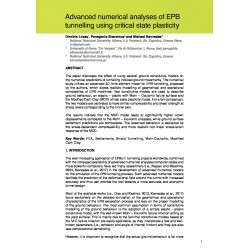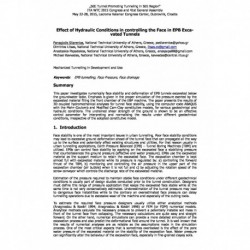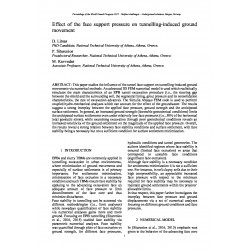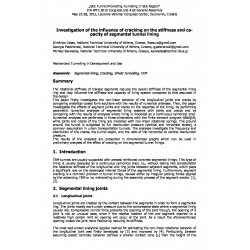No document
Search & filter
Search for a publication
Search & filter
List of products by author: D. Litsas
-
Advanced numerical analyses of EPB tunnelling using critical state plasticity
Abstract: The paper discusses the effect of using several ground constitutive models on the numerical predictions of tunnelling induced ground movements. The numerical study utilizes an advanced 3D finite element model for EPB tunnelling, proposed by the authors, which allows realistic modelling of geometrical and operational complexities of EPB machines. Two constitutive models are used to describe...
0,00 € -
Effect of Hydraulic Conditions in controlling the Face in EPB Exca vated Tunnels
Abstract: This paper investigates numerically face stability and deformation of EPB tunnels excavated below the groundwater table. Emphasis is given in the proper simulation of the pressure exerted by the excavated material filling the front chamber of the EBP machine. The paper presents the results of 3D coupled hydromechanical analyses for tunnel face stability, using the computer code ABAQUS with the...
0,00 € -
Effect of the face support pressure on tunnelling-induced ground movement
Abstract: This paper studies the influence of the tunnel face support on tunnelling-induced ground movements via numerical methods. An advanced 3D FEM numerical model is used which realistically simulates the main characteristics of an EPB tunnel excavation procedure (i.e., the steering gap between the shield and the surrounding soil, the segmental lining, grout pressure and its consolidation...
0,00 € -
Investigation of the influence of cracking on the stiffness and capacity of segmental tunnel lining
Abstract: The rotational stiffness of cracked segments reduces the overall stiffness of the segmental lining ring and may influence the stiffness and capacity of lining system compared to that assumed in the design. This paper firstly investigates the non-linear behavior of the longitudinal joints and cracks by comparing analytical closed form solutions with the results of numerical analyses. Then, the...
0,00 €




